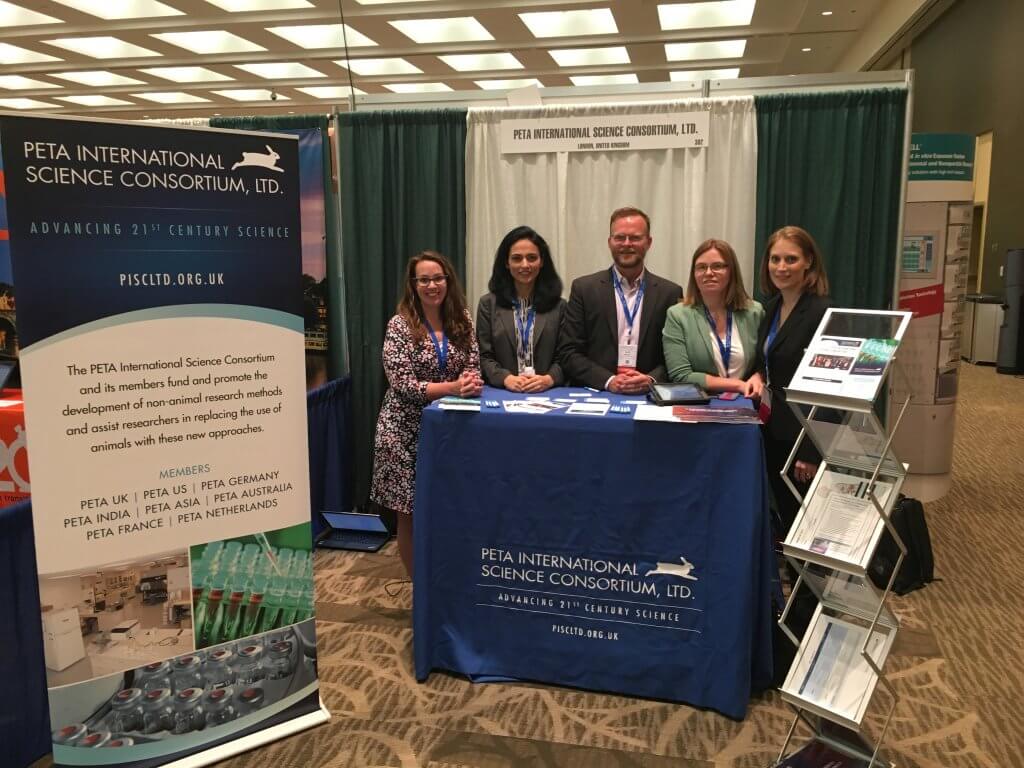Tenth World Congress on Alternatives and Animal Use in the Life Sciences
Seattle, Washington, USA
August 20-24, 2017
Visit the PETA Science Consortium International anytime during the conference at BOOTH #302
ORAL PRESENTATIONS
Lessons learned: US EPA Office of Pesticide Programs acceptance of alternative eye methods
Amy J. Clippinger1; Erin Hill2; David Allen3, Rodger Curren2
1PETA Science Consortium International e.V.
2Institute for In Vitro Sciences, Inc.
3Integrated Laboratory Services, Inc-NICEATM
Time: Wednesday, August 23, 2017 at 14:00 – 14:15
Location: Washington State Convention Center, Rooms 613-614
Abstract: A joint effort between industry, NGOs, and the EPA has led to the development of a decision tree approach using three in vitro/ex vivo assays to determine eye irritation under the EPA Office of Pesticide Programs’ (OPP) hazard classification and labeling system. A policy document issued by the EPA in 2013 and updated in 2015 describes the alternate testing framework that industry could apply to new registrations of antimicrobial cleaning products (AMCPs) and, on a case-by-case basis, to conventional pesticide products. This testing strategy has been successfully applied to support the registration of new AMCPs; however, it has been significantly underutilized. Barriers, including reviewer variability and lack of international harmonization, were identified. This presentation will discuss recent steps taken to address these barriers and to expand use of the alternative strategy to the evaluation of conventional pesticides. Insights revealed during this project that could improve the implementation of similar alternatives efforts in the future will also be discussed.
An integrated approach for assessing the inhalation toxicity of nanomaterials
Monita Sharma1, Barbara Rothen-Rutishauser2, Hana Barosova2, Savvina Chortarea2, Fikad Zerimariam2, Martin J. D. Clift3, Vicki Stone4, Patrick Hayden5, Anna Maione5, Amy J. Clippinger1
1PETA Science Consortium International e.V.
2Adolphe Merkle Institute, University of Fribourg
3In Vitro Toxicology Group, Swansea University Medical School
4Heriot-Watt University
5MatTek Corporation
Time: Monday, August 21, 2017 at 16:15 – 16:30
Location: Washington State Convention Center, Room 608
Abstract: Pulmonary fibrosis has been linked to prolonged exposure to multi-walled carbon nanotubes (MWCNTs). Mono- and co-cultures of human cell lines—including alveolar epithelial cells (A549), fibroblasts (MRC-5), and macrophages (THP-1)—were exposed to 2 types of MWCNTs (Mitsui-7 and Nanocyl) at different concentrations in suspension (5, 10, and 20 ug/mL) and at the air-liquid interface (ALI) (2-10ug/cm2) to assess the pro-fibrotic response. 96 h exposure of mono-cultures to Mitsui-7 induced pro-imflammatory (interleukin (IL)-8, tumor necrosis factor-alpha, and IL-1-beta levels) and pro-fibrotic response (osteopontin levels). Co-cultures exposed at the ALI revealed that longer exposures are more suitable to predict pro-fibrotic effects. This work is complemented by studies in a reconstructed human alveolar tissue model (EpiAlveolarTM, MatTek Corp). When used in an integrated approach with other in vitro and in silico methods, this system could be used to predict lung toxicity of substances.
Development of recombinant human diphtheria antitoxin
Jeffrey Brown1; Michael Hust2; Esther Wenzel2
1PETA Science Consortium International e.V.
2Technische Universität Braunschweig, Institut für Biochemie, Biotechnologie und Bioinformatik Abteilung Biotechnologie
Time: Thursday, August 24, 2017 at 10:15 – 10:30
Location: Washington State Convention Center, Rooms 611-612
Abstract: Diphtheria antitoxin (DAT) is a life-saving drug, but the way it and other antitoxins are manufactured hasn’t changed in more than 100 years. As with most therapeutic antitoxins, DAT is produced from the serum of equines who have been hyperimmunised by repeated toxin injections. In addition to documented animal welfare problems at facilities where hyperimmunised equine serum is produced, equine antitoxins can cause adverse health effects in humans who receive them. In recent years, public health authorities have noted a global shortage of equine DAT and called for the development of alternative products. As a first step toward developing a non-animal replacement for equine DAT, the PETA Science Consortium International e.V. is funding the development of human monoclonal antibodies against diphtheria toxin that can be produced in cell culture. Experts at the Technische Universität Braunschweig have developed 127 antibody candidates and are currently characterizing their neutralization activity, stability and producibility in IgG format, which will be critical for future clinical development.
POSTER PRESENTATIONS
Towards the replacement of fetal bovine serum in cell culture applications
Gilly Stoddart1, Christopher Faβbender1
1PETA Science Consortium International e.V.
Integrating alternative approaches to replace animals in inhalation toxicity testing
David Allen1, Dan Wilson2, Jon Hotchkiss2, Steven Morefield1, Warren Casey3, Amy Clippinger4
1ILS-NICEATM
2Dow Chemical Company
3NICEATM
4PETA Science Consortium International e.V.
The long hard road to globally eliminating the chronic toxicity test in dogs
Patricia Bishop1, Amy Clippinger1
1Regulatory Testing Department, PETA
Development of a targeted mass spectrometry protein assay to identify early stages of pulmonary response to carbon nanotube exposure in a 3D lung model
Gina Hilton1,2, Hana Barosova3, Barbara Rothen-Rutishauser3, Michael Bereman1
1North Carolina State University
2PETA Science Consortium International e.V.
3Adolphe Merkle Institute, Université de Fribourg

